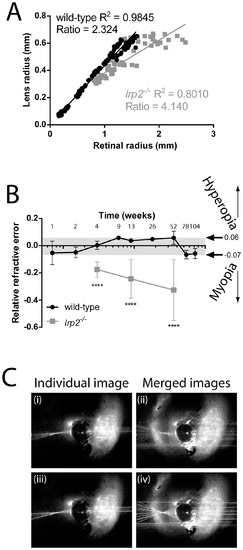Fig. 4
- ID
- ZDB-FIG-150211-16
- Publication
- Collery et al., 2014 - Rapid, Accurate, and Non-Invasive Measurement of Zebrafish Axial Length and Other Eye Dimensions Using SD-OCT Allows Longitudinal Analysis of Myopia and Emmetropization
- Other Figures
- All Figure Page
- Back to All Figure Page
|
SD-OCT used to measure the relationship between zebrafish retinal radius and lens radius, or relative refractive error. A. Wild-type zebrafish retinal radius shows a very good linear relationship with lens radius, and the best-fit line can be used to calculate the ratio coefficient which predicts correct retinal radius for each eye from the measured lens radius. lrp2 retinal radius: lens radius ratios have poorer linear relationships and have a higher ratio coefficient predicting that each lrp2 eye will have a longer required focal distance than wild-type. B. Relative refractive error compares the difference between calculated retinal radius based on lens radius measurements and observed retinal radius (center of lens to back of RPE). Relative refractive errors are made from a general equation, and individual wild-type sample groups are shown at each timepoint to demonstrate the variability seen when using this equation (grey bar shows lowest and highest average values). lrp2 zebrafish are more myopic than wild-types and consistently become more myopic as they age. Error bars show SD. C. Example of laser-assisted ray-tracing through a dissected lens to calculate focal length. Shown are individual images (i, iii), or composites (ii, iv) to indicate the light-ray intersection point either without line tracing (i, ii), and with lines tracing (iii, iv) to aid visualization. |
| Fish: | |
|---|---|
| Observed In: | |
| Stage Range: | Days 21-29 to Adult |

